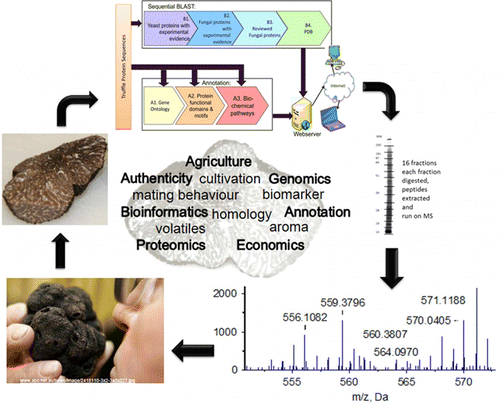Scientists unearth secrets of Perigord truffles, the culinary 'black diamond'

Just in time for the holidays when cooks in France and elsewhere will be slipping bits of the coveted black Périgord truffle under their turkeys' skin for a luxurious flavor, scientists are revealing the secrets that give the culinary world's "black diamond" its unique, pungent aroma. Their study, which could lead to better ways to determine the freshness and authenticity of the pricey delicacy, appears in ACS' Journal of Proteome Research.
Mark Baker, Shoba Ranganathan and colleagues note that the harvest of the Périgord truffle, a fungus that grows underground around the roots of oak and hazelnut trees in winter, has plummeted recently due to climate change, the loss of arable land and the cultivation of lower-quality truffles. Paired with an increase in demand from "foodies" seeking exotic flavors, prices for this truffle have skyrocketed to more than $900 per pound. Though long celebrated in the kitchen, only recently has the black Périgord truffle garnered scientific attention. In 2010, European scientists published the full genome of the Périgord, but this raw blueprint remained largely un-mined. In their report, Baker and Ranganathan's team go beyond the genetic code to identify and describe the truffle's proteins for a better understanding of the culinary delight.
By marrying techniques in bioinformatics and proteomics, they combed databases to unearth what proteins make the black Périgord truffle, which they obtained from the Marshalls' Terra Preta truffière in Braidwood, New South Wales, unique. They found that more than 2,500 proteins out of the truffle's nearly 13,000 were similar to existing proteins in other fungi, and they identified nine proteins that contribute to the cherished aroma. "This study has resulted in the functional characterization of novel proteins to increase our biological understanding of this organism and uncovered biomarkers of authenticity, freshness and perfume maturation," the scientists state.
More information: Unlocking the Puzzling Biology of the Black Périgord Truffle Tuber melanosporum, J. Proteome Res., Article ASAP. DOI: 10.1021/pr400650c
Abstract
The black Périgord truffle (Tuber melanosporum Vittad.) is a highly prized food today, with its unique scent (i.e., perfume) and texture. Despite these attributes, it remains relatively poorly studied, lacking "omics" information to characterize its biology and biochemistry, especially changes associated with freshness and the proteins/metabolites responsible for its organoleptic properties. In this study, we have functionally annotated the truffle proteome from the 2010 T. melanosporum genome comprising 12 771 putative nonredundant proteins. Using sequential BLAST search strategies, we identified homologues for 2587 proteins with 2486 (96.0%) fungal homologues (available from biolinfo.org/protannotator/blacktruffle.php). A combined 1D PAGE and high-accuracy LC–MS/MS proteomic study was employed to validate the results of the functional annotation and identified 836 (6.5%) proteins, of which 47.5% (i.e., 397) were present in our bioinformatics studies. Our study, functionally annotating 6487 black Périgord truffle proteins and confirming 836 by proteomic experiments, is by far the most comprehensive study to date contributing significantly to the scientific community. This study has resulted in the functional characterization of novel proteins to increase our biological understanding of this organism and to uncover potential biomarkers of authenticity, freshness, and perfume maturation.
Journal information: Journal of Proteome Research
Provided by American Chemical Society




















